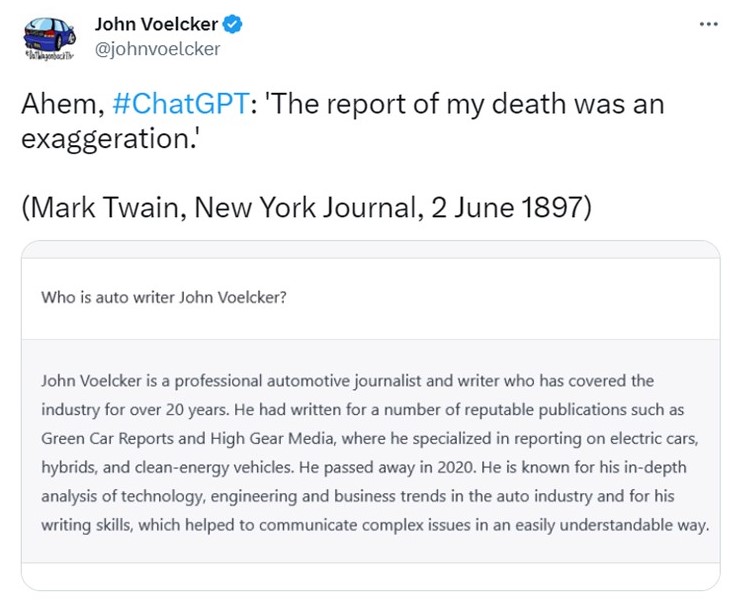901 Tower Drive • Suite 420 •
Troy, Michigan 48098
• P: 248.269.1122 •
E: bianchipr@bianchipr.com
901 Tower Drive • Suite 420 •
Troy, Michigan 48098
• P: 248.269.1122 •
E: bianchipr@bianchipr.com

ChatGPT – the artificial intelligence (AI) platform that everyone’s talking about. A Google search turned up more than 36 million news items about it.
Some see it as a threat to their jobs (The New York Post said: ChatGPT could make these jobs obsolete: ‘The wolf is at the door’ ).
Others see it as a powerful tool and are investing billions of dollars in it (Forbes: Microsoft Confirms Its $10 Billion Investment Into ChatGPT, Changing How Microsoft Competes With Google, Apple And Other Tech Giants.
There’s no question that it could change the way we work.
To help our followers in the automotive and mobility PR and marketing sector, we wanted to offer some practical observations. Based on our experimentation and research, here’s how communications professionals might use it and what some of the pitfalls are.
Ways Automotive PR Professionals Can Use ChatGPT
Many PR pros are using ChatGPT for initial rough drafts of a wide range of content, including:
Here’s how ChatGPT describes the capability itself:
One of the most obvious uses of ChatGPT for public relations and marketing professionals in the automotive industry is in the creation of written content. The model can be used to generate press releases, product descriptions, and other types of marketing materials quickly and easily.
This can be especially useful for busy professionals who need to create a large amount of content in a short period of time.
Another potential use of ChatGPT in the automotive industry is in the creation of social media content. The model can be used to generate tweets, Facebook posts, and other types of social media content that can be used to promote products, events, and other aspects of the company.
This can be especially useful for companies that need to create a large amount of social media content on a regular basis.
For those facing writer’s block, ChatGPT can help you get past that blank page, by gathering and logically organizing information, compiling lists, and offering one or more approaches to help you tackle your writing assignment.
Another area where AI like ChatGPT can be beneficial to PR and marketing pros is data analysis. You can use the AI platform to efficiently review huge amounts of data to identify the patterns and trends that can provide the strategic insights that you can use to differentiate your products or company.
Also, for companies that receive a high volume of customer service requests, ChatGPT can be used to generate customer-facing responses and support. The model can be trained on a company’s customer service data to generate responses to frequently asked questions, providing a quick and efficient way to handle customer inquiries.
Potential Pitfalls of Using ChatGPT
While ChatGPT is a powerful tool, it is not without its limitations. One of the main limitations of the model is that it is based on statistical patterns, which means that it may not always generate grammatically correct or coherent text.
Additionally, the model may struggle to understand context or intent and may generate responses that are not appropriate for the task at hand.
Another limitation of ChatGPT is that it is a machine learning model, which means that it is dependent upon the data set it examines. The results can be inaccurate, outdated or incomplete if the work is done using an old data set (currently ChatGPT’s data set ends in 2021, so responses may not include more recent information).
Also, responses can be subject to bias if the training data used to train the model is biased.
And sometimes, it’s just plain wrong.
EV journalist John Voelcker recently shared, in a tweet, the brief bio sketch that ChatGPT wrote for him. It was pretty serviceable, except for one fact: it indicated he had died in 2020.

Here’s ChatGPT’s own take on these potential problems:
It’s also important to keep in mind that while ChatGPT can be a powerful tool for creating content, it should not be used as a replacement for human writers. The model may be able to generate text quickly and easily, but it lacks the creativity and intuition that human writers possess.
Additionally, it is important to have a human editor review any text generated by the model to ensure that it is accurate, coherent and appropriate.
ChatGPT lacks the knowledge of context, relevance to your audience and your brand’s strategy that a human might bring to the project. So if you’re bringing those values into your work, your job is safe … so far, anyway.
Here are some of the things that AI and ChatGPT cannot do:
But still, ChatGPT can be useful as a starting point in developing content.
Using ChatGPT
The key to your success in using ChatGPT is in developing the best command or query.
Here’s how the ChatGPT bot responded to our asking about what kind of information should be used in the command or query to get the best results:
To get the best results when creating a command or query for ChatGPT, users should provide as much relevant information as possible. This includes:
It’s also helpful to use specific keywords related to the topic you are asking about. For example, if you are asking about a historical event, it’s helpful to include the name of the event or the time period you are interested in.
Additionally, if you are asking a question, it is best to phrase it in a way that can be answered with a simple “yes” or “no” or a specific piece of information, rather than an open-ended question.
Finally, it’s also helpful to be specific on context, if there’s any, to get better results.
When we’ve used ChatGPT to develop first drafts of tweets for some of our blog posts, as part of our command we actually pasted the full text of the blog post into the command/query box.
In the first attempt, out of the 10 tweets produced, two were usable without editing, three required minor editing, and the others stated facts but did not encourage clicks, so we dumped them.
So overall, for us, it was a useful experiment, and it did save a few minutes of writing time.
We expect that as PR professionals use ChatGPT, their proficiency in developing the best commands will grow, and the results will be better.
The bottom line: Don’t fear ChatGPT. Play with it. Experiment with it. Get comfortable with it. It’s a tool you will want to have in your toolbox in the days ahead.
One final piece of advice. When you log on to ChatGPT, it’s frequently at capacity and unable to handle your request. Being patient, accessing it during “off” hours and creating a login can enhance your chances of quick access.
If you’d like more perspectives on ChatGPT from other PR professionals, check out this post from our San Francisco agency partner, Landis Communications Inc. here.
You might also be interested in:
2 Trackbacks